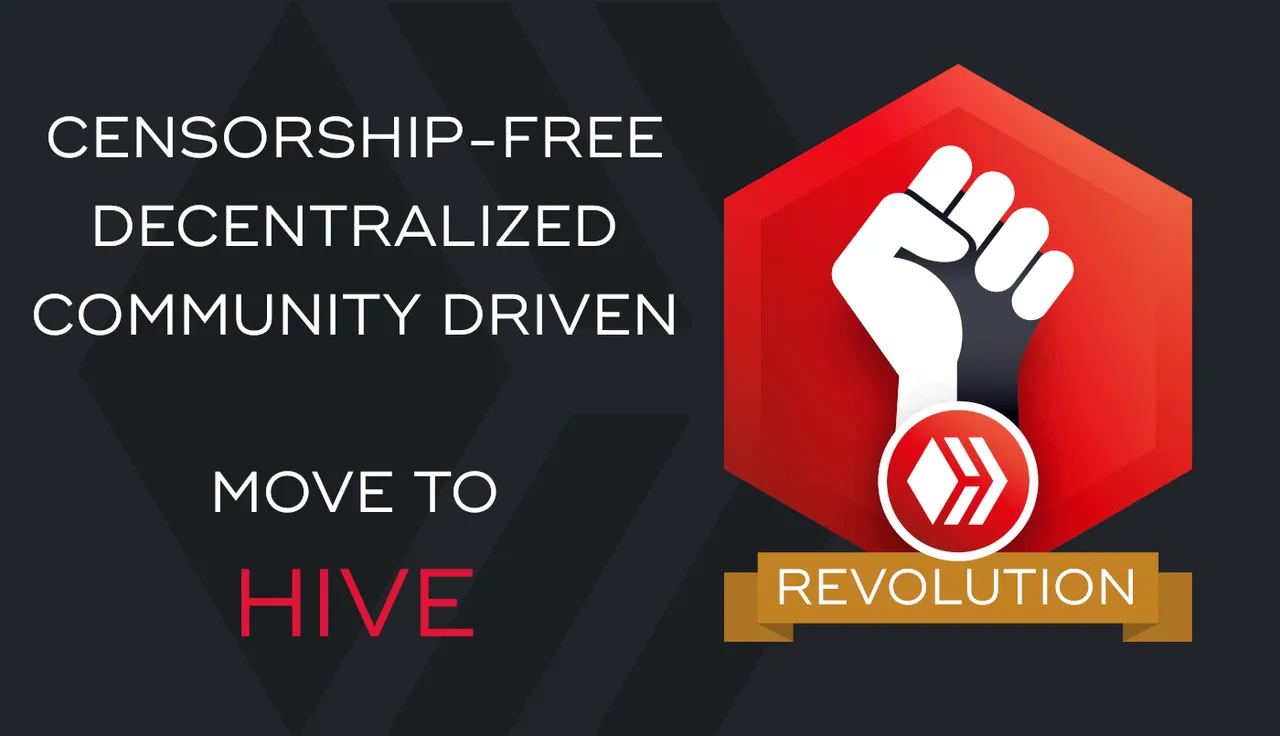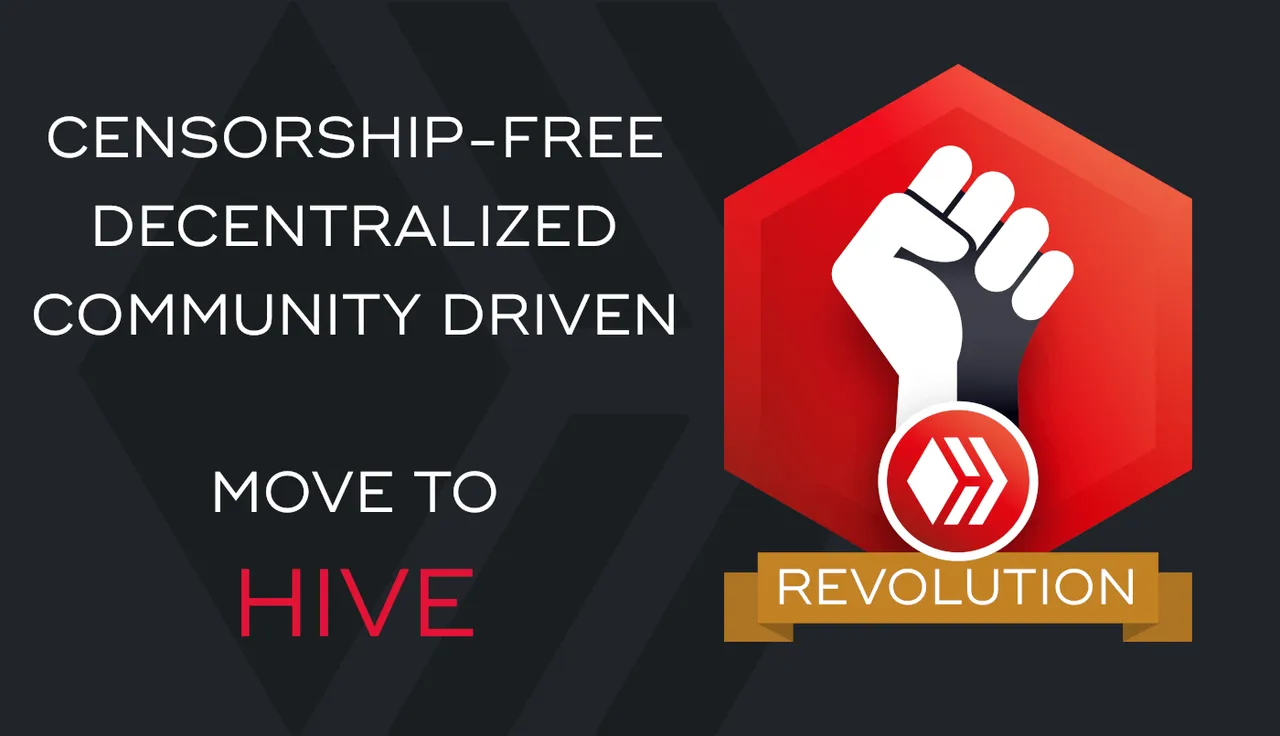Hi Everyone,

This is the fifth and final part of my series investigating the operation of the Steem ecosystem. The series has investigated, identified and articulated many of the problems with the distribution of rewards in the current Steem ecosystem.
There are several ways of earning rewards on Steem. I have simplified these into five categories. These categories are content creation, content curation, applications and services, witnesses, and passive income. All of these categories obtain rewards from the increase in supply of Steem, also known as the rewards pool. The right incentives need to be in place for the right balance of activity. All five areas are important for different reasons.
The first four parts of the series can be accessed using the following links:
- Part 1 – Witnesses
- Part 2 – Content creators and curators
- Part 3 – Applications and services
- Part 4 – Passive Income
These posts have also presented a wide range of potential solutions to these problems. The posts have highlighted the strengths and weaknesses of each solution as well as the possibilities of combining solutions. So far, the posts have only investigated solutions that tackle problems for a particular group of users. This post will combine solutions to analyse the effect on the overall rewards ecosystem. To address the problems that have been highlighted will require a combination of solutions as individual solutions have their weaknesses as well as do not address all the highlighted problems.
Summary of identified problems with the Steem rewards system

Before I discuss the effect of a combination of solutions I would like to summarise the key problems identified for each category of user. These summaries have been extracted from the previous four parts of this series.
Witnesses

Just a few accounts have positioned themselves to dictate which witnesses have the most influence. This puts the top witnesses in a position where they only need to please these few accounts to maintain their position in the top 20; this has led to complacency for some of the witnesses.
Very popular witnesses that do not have the support of these few accounts are unlikely to get into the top 20. This a strong disincentive for them to perform. It would also be considerably more difficult for one person to have multiple witness accounts if they needed to provide frequent evidence of activity.
Another problem is the attentivity of @blocktrades, @pumpkin, and @clayop to the activities of the witnesses. @pumpkin continued supporting some witnesses for many weeks after they disabled their witness accounts.
Content creators and curators

The ratio of content creators to curators is inconsistent with most other social media platforms and the internet as a whole. Steem does not have a sufficient number of curators for the number of posts on the platform. There does not appear to be sufficient incentives for users to make the effort to look for good content to upvote. The lack of incentive to curate will result in a lack of incentive to create good content.
Applications and services
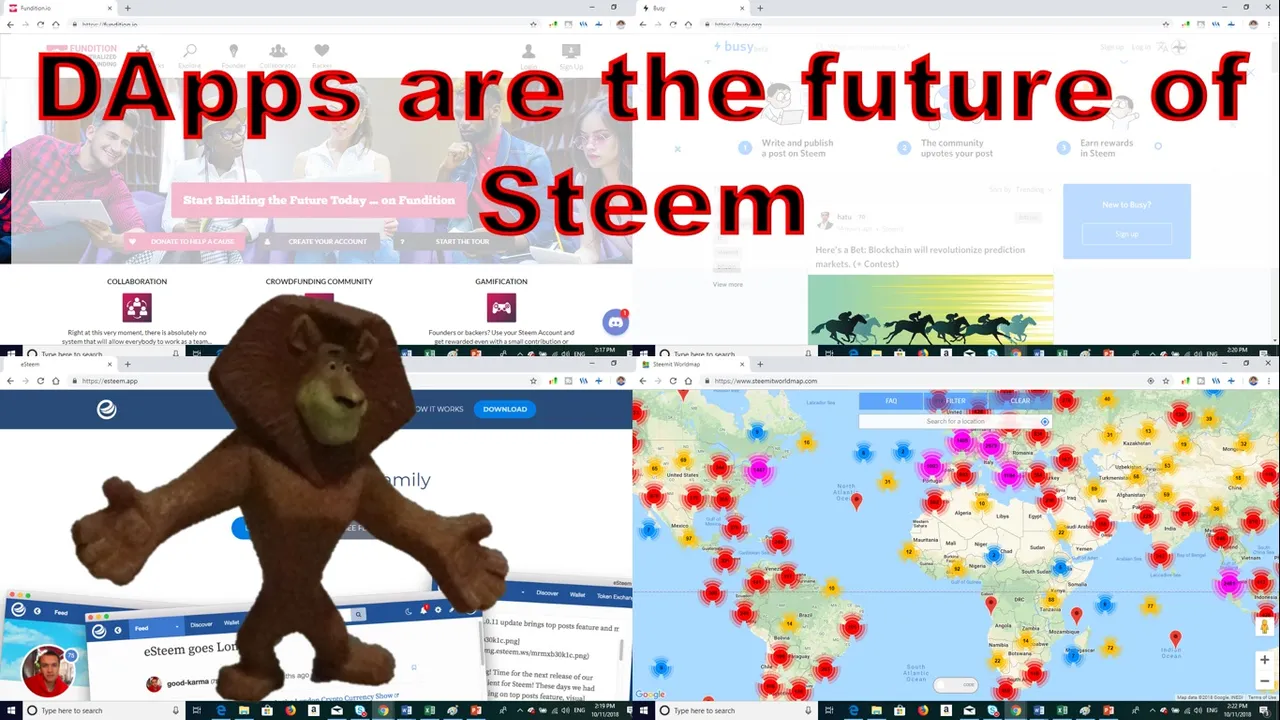
Applications have many avenues for collecting revenue to support the growth of their operations. In my opinion, the best approach for funding and building a user base for an application is from delegated Steem Power. The application can upvote its users to build its user base as well as earn curation rewards to fund operations and developments. The biggest problem is obtaining delegated Steem Power to begin with. Many good applications have very little Steem Power to help them grow. There is also the concern regarding the reliability of the delegation, delegators could remove their delegation at any time.
Smart Media Tokens (SMT) could potentially offer a great stream of funding but there is considerable uncertainty of the extent of this funding. We will have a much better idea of the effectiveness of SMTs to obtain funding for applications in 2019.
Services such as vote selling are gaining a very large proportion of the current rewards pool. It would be difficult to improve the profitable of these services. I strongly believe these services are obtaining a disproportionately large share of the rewards. If changes are to be made to the rewards system on Steem, these changes should work against vote selling and bid-bot profitability.
Passive Income
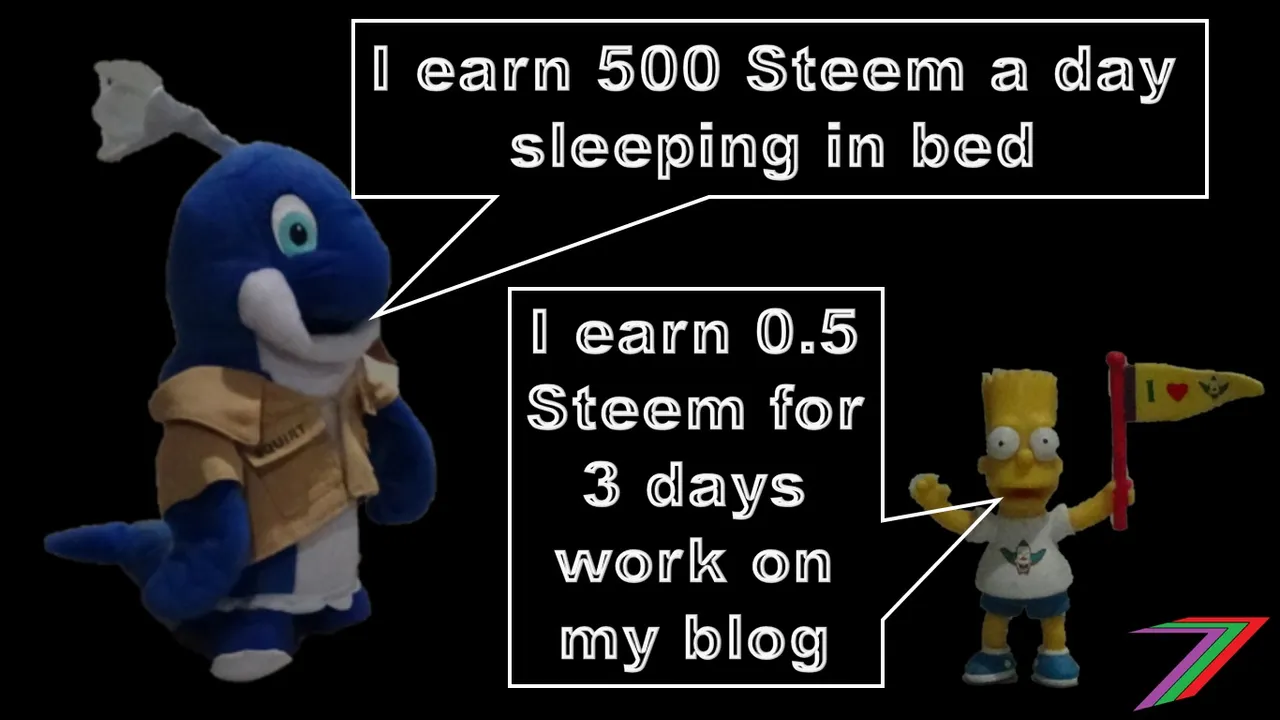
Many forms of passive income produce higher returns than creating content and/or curating content. Good curators might only receive 30% to 40% of the value of their upvote. Vote selling, delegating to bots, and self-voting typically returns over 80% of the upvote. Bid-bots also time voting to maximise daily rewards (i.e. upvotes 10 times a day).
What is also concerning is that the annual return from passive income through delegating to bots and possibly vote selling is greater than the percentage increase in the supply of Steem. This could be because the rewards obtained by the content creators and curators are not covering their investment in Steem. This could also be because of the inactivity of large accounts such as @steem and @steemit.
Passive income, as the name suggests, requires minimal or no effort. Most people would rather not work if it meant receiving the same or higher rewards than working.
For the Steem ecosystem to run effectively, rewards need to align with the value added to the platform. For example, if a user has 50,000 Steem Power, the user should earn more by actively contributing to the platform than simply delegating and walking away. In the current Steem ecosystem, this is not the case.
Recommended Solutions

Based on my own analysis of potential solutions as well as some feedback from readers. I have determined a combination of solutions that I believe will far better align rewards to value added to the platform. These proposed solutions are as follows:
- Witness ranking
- Witness votes expire after 6 months
- Change payout to 25% to content creators and 75% to curators
- Include SBD in payouts to curators
- Separate upvote and downvote mana pools
- Improve the Steem frontend user interfaces
- Introduce curation beneficiaries to enable delegation of Steem Power to curators
- Delegation contracts
Most of the above-suggested solutions do not work particularly well in isolation but work to reinforce each other.
Witness ranking

Each account has 30 equally weighted witness votes. The top 20 witnesses earn the highest rewards based on the number of blocks produced. Steem currently has the vulnerability of very large stakeholders being able to control the determination of the top witnesses. This is because of several reasons such as:
- Many of the large stakeholders do not participate in witness voting; therefore, the few that participate have more influence.
- Accounts have more votes than top witness positions; therefore, a very large account could determine all 20 top witnesses.
There are many disadvantages of just a few accounts influencing which witnesses reach the top 20. These disadvantages include:
- complacency of top witnesses
- witnesses aiming to please just a few stakeholders rather than the community
- new witnesses unable to gain visibility
- popular witnesses, who are not favoured with largest accounts, not getting into the top 20
- witnesses creating multiply accounts because of the potential lack of scrutiny of activity
In Part 1, many possible solutions were investigated. Most of them are likely to improve the current situation but they would also have several problems.
Of the solutions described in Part 1, I believe a combination of ranking witnesses and expiring votes after a period (e.g. 6 months) would be the most effective.
Ranking witnesses enables users to prioritise witnesses based on preference of activity. There are many advantages of ranking witnesses compared to just selecting witnesses using equally weighted votes. These advantages include:
- Restricting the influence of the large stakeholders to a smaller number of witnesses
- Accounts can display preference between witnesses
- More onus on witnesses to perform in order to maintain rank
- More pressure on witnesses to be transparent regarding activities
- More opportunity for new witnesses as they can achieve an initial lower rank and aim to climb higher as they demonstrate their competence.
- Witness positions are less likely to change significantly, as large stakeholders can change ranking order instead of dropping votes completely.
The weights applied to ranking could be described as follows: Number one ranked witness would obtain full stake approval, number two ranked could obtain 90% approval, and number three could obtain 81% approval. This weighting reduces the next rank by 10%. It is possible that 5% or maybe 15% could work better. Table 1 demonstrates an example using 10% reduction per rank for several of the largest participating stakeholders in witness voting.
Table 1: Effect of ranking on weight of witness approval for accounts with high delegated proof of stake (DPOS)
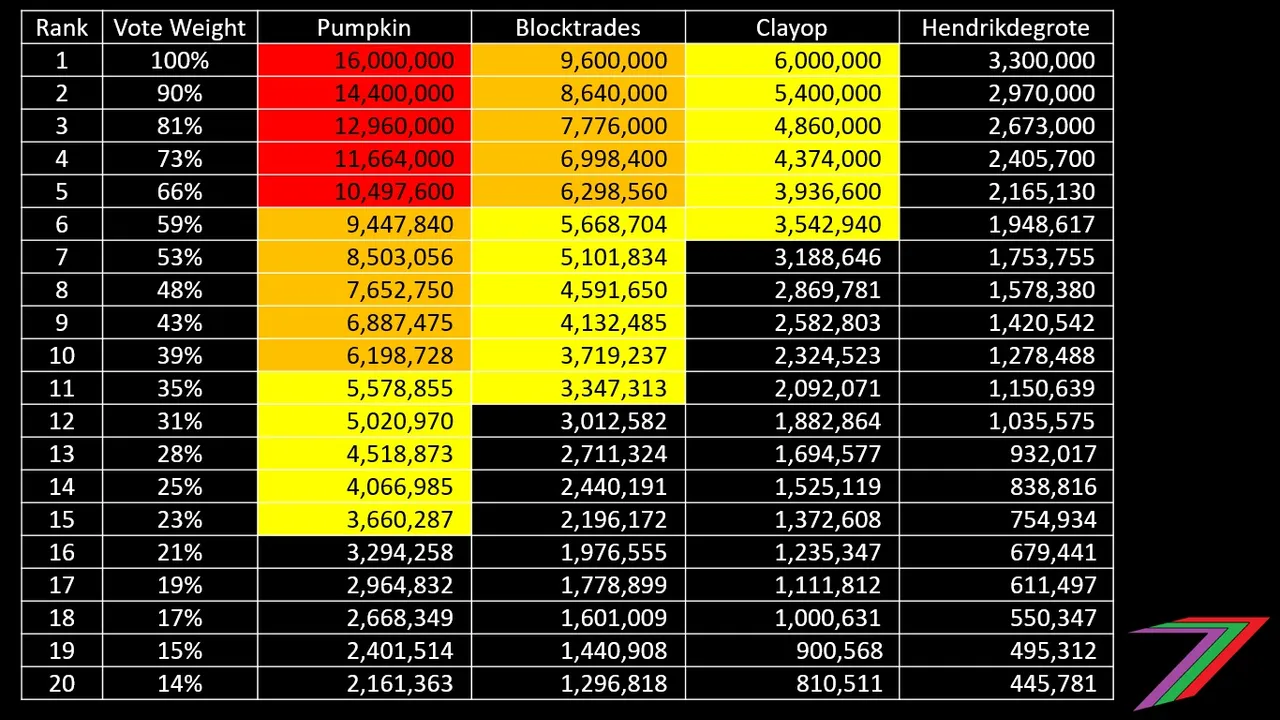
Note: colours represents higher weight of votes over other accounts considered in the table
Using just a 10% reduction per rank, @pumpkin/@freedom only has five witness votes with greater weighting than @blocktrades and @blocktrades only has five witness votes with greater weighting than @clayop. This system maintains large stakeholders influence over the witnesses that the stakeholder considers most valuable but reduces influence over all 20 witnesses.
Witness votes expire after 6 months
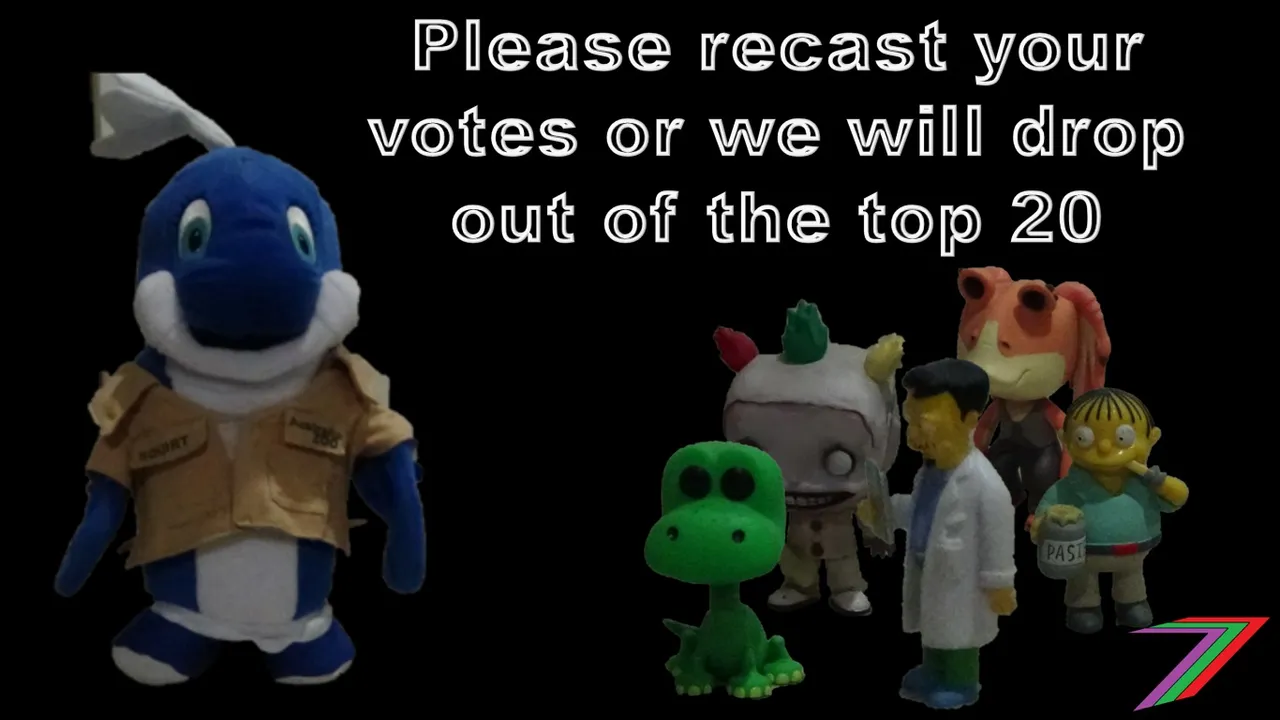
There is a risk that accounts are unable to participate in the Steem ecosystem for any number of reasons. If votes do not expire, the top witnesses can become partially locked in, this is especially true if the account voting has significant Steem Power. The voting process would also need to be changed to prevent the automation of voting.
Change payout to 25% to content creators and 75% to curators

Currently, 75% of the post payout is rewarded to content creators and 25% to curators. The low rewards to curators has become a disincentive to curate content. Those invested in Steem earn considerably higher rewards from selling votes or delegating Steem Power to bid-bots. Several people, including myself, have suggested changing rewards to 50% to content creators and 50% to curators. This is a much greater incentive to curate content but it will probably not significantly change behaviour as selling votes and delegating to bid-bots returns about 80% of the upvote, which is still considerably higher than 50%.
Increasing the curation rewards to 75% approximately equates the rewards of curation almost immediately with the rewards from vote selling and delegating to bots. Higher curation rewards will force the restructure of the rewards to vote selling as most of the rewards will be earned as curation rewards rather than the payment for the vote. The curation rewards for those selling votes are likely to be significantly less than 75%. This is because of front-running of large upvotes and the separate downvote mana pool, which I will explain shortly. If curation rewards are as high as 75%, front-running large upvotes will become very profitable.
Votes selling services and bid-bots do not upvote the buyer/bidder immediately. There is sufficient time for other accounts to vote before the bots. Front-running could potentially double the curation rewards to the upvoters. Currently, there are some users obtaining over 50% curation rewards. At 75% curation rewards, these users could get 150% of their upvote back. This is far superior to rewards from vote selling, delegating to bots and even self-voting. I would predict that curation rewards to bots would drop to about 50%. If vote-selling offers zero ROI to vote buyers, the returns bid-bot owners and delegators combined would only equal 75% of an upvote. Downvoting of low quality posts promoted by bots could possibly push the returns to as low as 70%, which would be less than curating content. If operating bots does not earn as much as curating content, bot services are likely to close.
If bots no longer operate, it is likely that accounts will sell their votes directly using services such as @smartmarket and @minnowbooster. These services will still offer the potential to earn about 80% to 90% of an upvote to the seller and possibly even above 100% if vote selling happens to front-run bid-bot upvotes. If the bid-bots stop operating, vote selling will no longer benefit from front-running. Instead, those front-running bid-bots will switch their attention to front-running whales and vote selling services. The front-running will most likely reduce earnings to close to 75% and downvotes could reduce vote selling returns to under 75%. Front-running will become the most profitable tactic to earn the highest rewards. Front-running combined with downvoting will also render bid-bots and vote selling unprofitable compared to curating. Without vote selling and bid-bots, front-running will target whales that autovote content. This will put pressure on Whale accounts to change voting behaviour or else they will lose curation rewards.
Another key advantage of considerably higher curation rewards is that applications will not need to charge beneficiary rewards, as their earnings will substantially increase from curating their users’ content. Beneficiary rewards makes applications unattractive compared to posting straight to Steemit. For example, a user could post on YouTube and share the video in a Steemit post for zero beneficiary cost. Whereas, DTube charges 10% beneficiary rewards.
Include SBD in payouts to curators

Changing curation rewards to 75% will not be an effective long-term strategy if the problems caused from the inability to successful peg Steem Blockchain Dollars (SBD) to US Dollars continues. Including SBD payouts to curators will rectify the redistribution effect between content creators and curators caused by the price of SBD increasing above US$1; see Part 2 for more information. If an author chooses 50/50 payout in Steem Power and SBD, the curator will also receive a 50/50 payout in Steem Power and SBD. An increase in price of SBD will affect the content creator and curator in the same way rather than favour the content creator.
Separate upvote and downvote mana pools

Creating a separate downvote mana pool supports the change of increasing curation rewards, as downvotes will affect the curator more than the content creator; 75% of the payout goes to the curators.
Downvotes, currently, are taken from the same mana pool as upvotes; therefore, downvoting punishers both the downvoter as well as the donwvoted. The penalty imposed on the downvoter is one of the reasons that downvoting is not popular. A separate downvote mana pool would remove the cost of the downvote to the downvoter. This is likely to encourage downvoting.
Combining a downvote mana with the higher (75%) curation rewards will likely eliminate the benefits of self-voting. For example, if someone gives himself or herself a 10 SBD self-vote on a low effort comment or post. A combined downvote of 2.5 SBD wipes out any gains the self-vote has over an upvote of somebody else’s content.
Improve the Steem frontend user interfaces
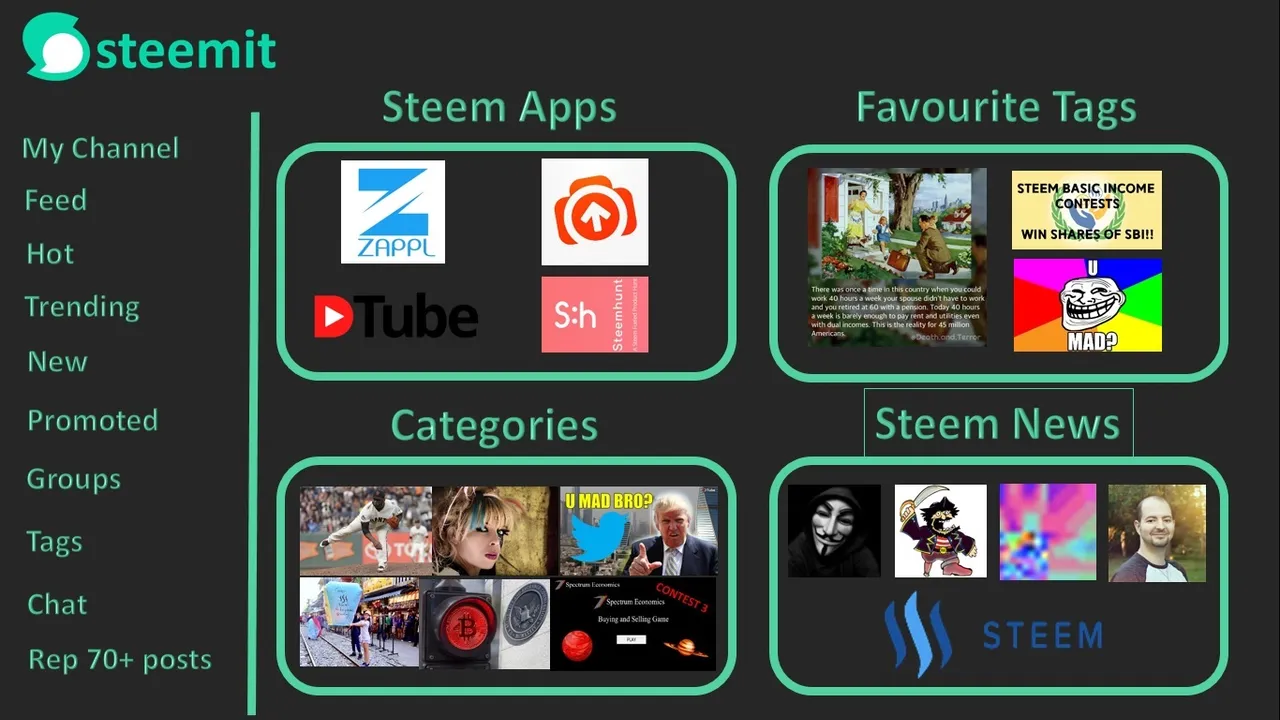
Curating content can be difficult on Steemit as content is not particularly easy to find. The front page of Steemit, as well as most other Steem frontends, is the all tags trending page. Most people like and look for particular content rather than just accept whatever happens to be on the front page. The front page should enable users to get to the content they want as easily as possible. This can be achieved with a front page that contains links to information people want to see. The picture above contains an example of an interface that enables users to reach the type of content they want faster. Users should be able to access applications as easily as possible. Users should not need to look for updates from witnesses and Steemit Inc. Users should be able to access the content they want to read or watch with simple links and not need to search through tags with very little meaning.
The removal of the all tags tending page also greatly reduces the incentive for accounts to spend excessively on votes from bots or vote selling services as the required value of a post to reach the top of a tag trending page is significantly lower. If accounts still excessively buy votes, if such services still exist, they can be downvoted, these downvotes will also effect the profitability of bots.
In the likely event of bots ceasing activities because of less revenue and better curating options, the frontends will need to offer promotion services themselves. Most forms of social media offer some form of paid promotion. These services normally charge based on exposure. This exposure could come in the form of introducing promoted content into the feeds of accounts that follow or create related content.
Another very basic change, which needs to be made to a Steem frontend user interface, is to include a view counter. The number of views is very important to content creators and will be very important to potential investors and advertisers.
Introduce curation beneficiaries to enable delegation of Steem Power to curators
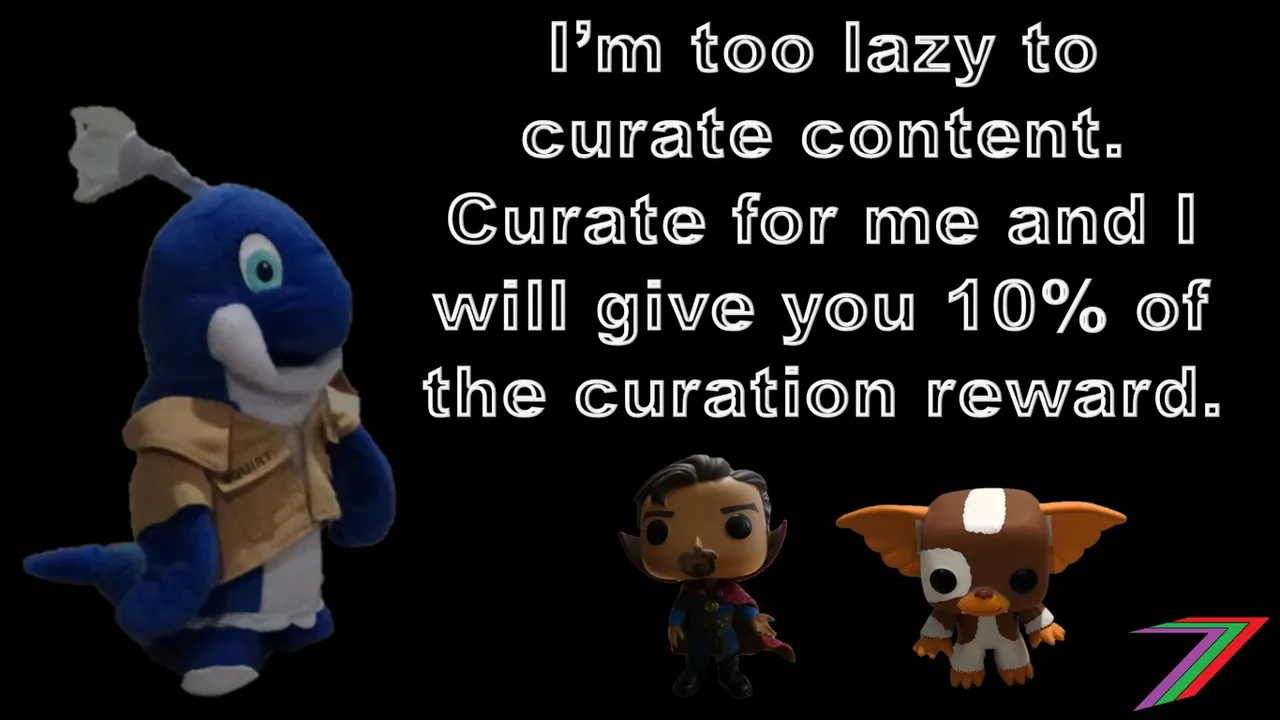
If delegating to bid-bots or vote selling is no longer a viable form of passive income and an investor does not have the time to dedicate to curating content, an alternative form of passive income needs to exist to cater for these types of investors. I suggest introducing curation beneficiaries.
High curation rewards enables a reasonably good return to those delegating curators. If beneficiary rewards are included in curation, the delegatee can include the delegator as a beneficiary in the rewards. In Part 2, I explain how beneficiary rewards could work using the following example:
Using the example of 75% curation rewards. A user may have 2000 of their own Steem Power, they could obtain another 18,000 in delegated Steem Power. They could arrange that the delegator obtain 90% and delegatee keeps 10% of the curation rewards from the delegated Steem Power. As the delegatee has 2000 of their own Steem Power, the delegatee would keep 19% of the curation rewards ((2000+1800)/20,000). If the delegatee is a good curator and earns 100% curation rewards on their upvotes (i.e. is able to pick good content and upvotes early), the delegatee would keep 19% of their upvotes as curation reward. Therefore, the delegator would earn 81% of the value of the upvotes, which is equivalent to capturing 90% of their own upvote if they had not delegated the Steem Power. Delegating to good curators would produce higher rewards than delegating to bots, if curation rewards are 75%.
To expand further on the above example. Two groups of users could be established. There would be one group of potential delegators who state the amount they want to delegate and the percentage of curation rewards they wish to receive. There would be another group of potential delegatees who state the amount they want to be delegated and the percentage curation rewards they are willing to offer to the delegator. Once agreement has been reached, beneficiary rewards on curation can be locked in the delegatee account settings.
Delegation contracts

To support the above-mentioned discussed beneficiary rewards on curation, delegation contracts can be agreed upon between delegator and delegatee. These contracts could be used to determine how the delegated Steem Power is to be used. The delegator should be able to state particular requirements such as how much can be used for self-voting etc.
I discuss delegation contracts in some detail in Part 3 of this series. In Part 3, delegation contracts are discussed in the context of delegating to applications. I believe this is where contracts will add the most value in regards to giving both delegator and delegatee more security in regards to future use of Steem Power and how that Steem Power is to be used.
Summary of proposed changes to each of the user groups
This section summarises, which proposed solutions affect, which groups of users and how these users are most likely going to be effected.
Witnesses

Witnesses will be effected by ranking of witness votes and expiring of witnesses votes.
Large accounts will have significantly less influence on all top 20 witness but will still be able to support witnesses they consider essential to Steem. New witnesses will have more opportunities to gain exposure by climbing the rankings instead of just hoping for large accounts to fully support them. Witnesses will not be locked in or locked out by accounts that no longer participate or observe Steem.
Content Creators

Content creators will be effected by all changes indirectly but will be most affected mostly by decreased share of the post payout (i.e. will receive 25% instead of 75%).
The percentage reduction in rewards will hurt content creators if other users such as curators and passive income investors do not change their behaviour. If the increased incentive to curate alters behaviour, content creators who create popular content will benefit greatly and those that create low effort and low quality content will be disadvantaged. This is enforced further, with the creation of a separate downvote mana pool.
The current 75% of the rewards going to content creators is not representative of reality. Many accounts buy votes which results in the content creator earning less than 5% of the post's payout. Accounts that do not buy votes for their posts loose visibility, therefore, these posts may earn 75% of the payout, but the payout is very small as other accounts would rather sell votes or delegate their Steem Power than curate content.
Popular content should obtain higher rewards when large accounts delegate to curators rather than to bots as manual curation can better assess the quality and value that content brings to the platform. I believe that large accounts would rather obtain 70% of their upvote back for supporting content that will help Steem grow than sell votes that will return, given the proposed changes, about 70% or less of the upvote back.
The net effect of the proposed changes could initially reduce the number of content creators but there will be more incentive for those that add value to stay. If because of these changes, the price of Steem increases, more content creators will be attracted to create content on Steem.
Even if the value of rewards do not increase for content creators, they will obtain more views. Many content creators consider the number of views and exposure as important if not more important than rewards.
Curators
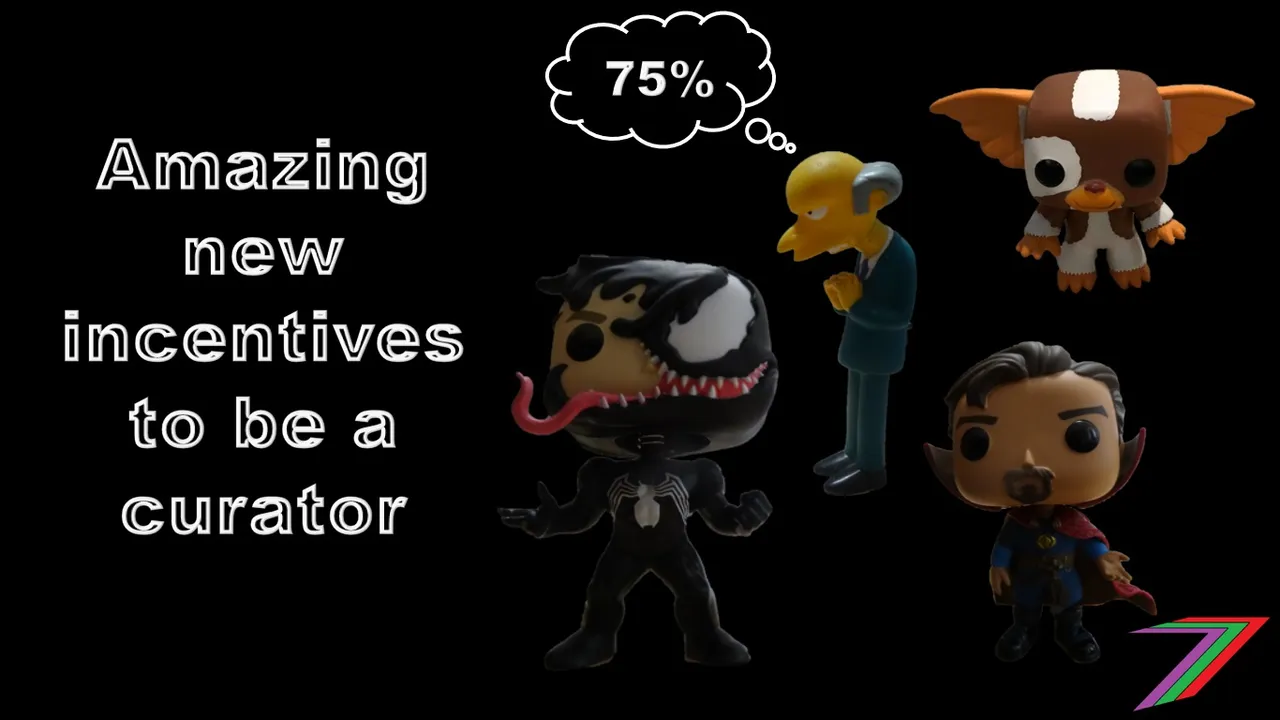
Curators will be effected by all changes other than those related directly to witnesses.
Curation is not very popular as it is very much under-rewarded compared to alternative activities such as vote selling and self-voting. Increasing curation rewards from 25% to 75% greatly increases the attractiveness of curation. Curating could be the most important element in the growth of Steem. Only 1% of those on the internet contribute to content creation. For that to be true on Steem, the platform needs a massive increase in the number of people viewing, reading, watching, and listening to content. The higher rewards will have a positive impact. Downvotes that hurt the curator more than content creator will help. Utilising delegated Steem Power from other large accounts will further increase rewards to curators. A frontend to Steem that enables users to get to the content they want as quickly and as easily as possible will improve retention thus increase curation further.
Steem can be emphasised as a social media platform where users are paid to enjoy content as well as have a say in what content is rewarded. Increased activity on Steem will also help facilitate the introduction of advertising into posts. Companies will only pay to advertise if the number of views reach a particular critical mass. At the moment, Steem is falling further away from a critical mass as the number of views are falling.
Applications
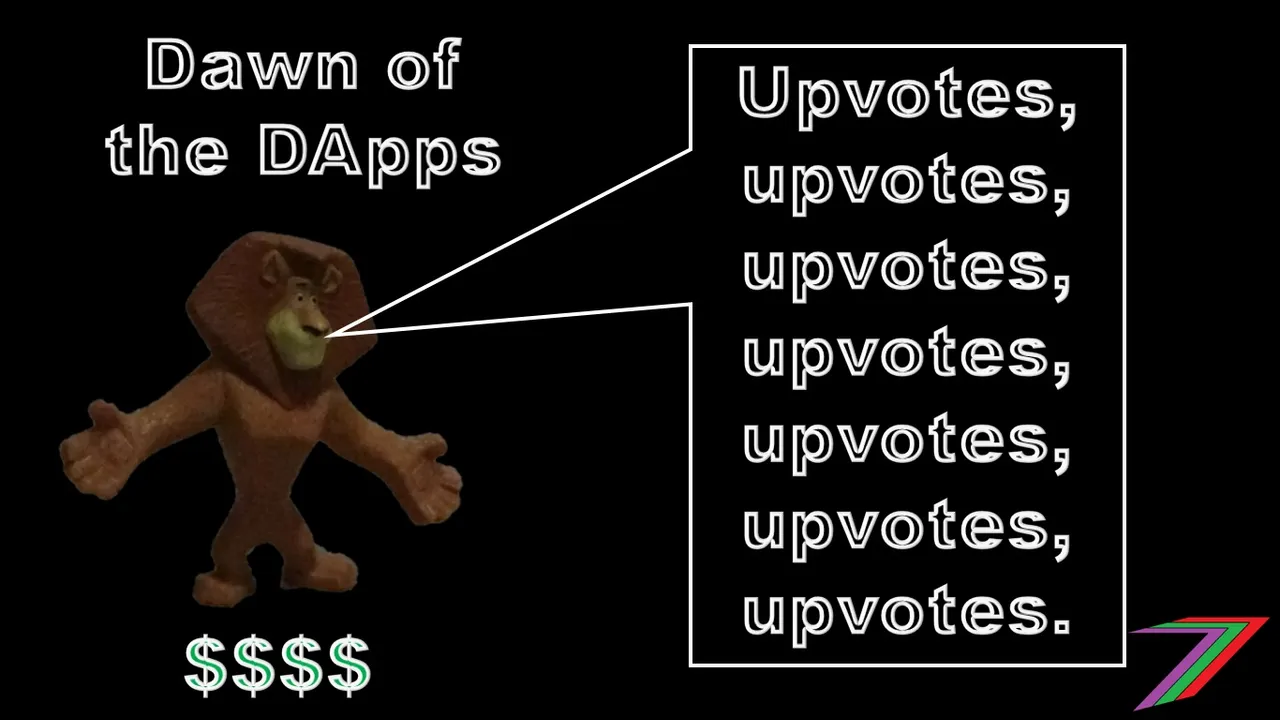
Applications will be effected by increasing curation rewards to 75% and delegation contracts.
The higher curation rewards can be used to fund applications without the need to charge beneficiary rewards to users. The applications will be more inviting to users who share their own content posted on other platforms such as videos directly to Steemit instead of using the Steem applications. Applications might be able to encourage larger delegations and will be able to offer higher rewards to the delegators because of the higher curation rewards.
Delegation contracts will offer security to applications as their delegation can not be unexpectedly removed. Instead, there will be a guaranteed period for the delegation, which will be maintained as long as the application operates according to the contract they have signed with the delegator.
Passive Income

Passive income will be affected indirectly by most of the proposed changes but more directly from increasing curation rewards to 75% and curation beneficiaries.
Curation beneficiary rewards will enable investors to benefit from the higher curation rewards. Passive income could produce returns consistently above 70% of an upvote.
Passive income from vote selling and delegating to bots will be reduced as curation takes a larger proportion of the rewards. Front-running and downvotes could reduce these rewards to below a 70% return per upvote. It is likely that vote selling and bid-bots will not operate or operate on a much smaller scale as the rewards will likely to be less than curating content. Self-voting short and low effort comments and posts will still be an option but lower the cost of downvoting from a separate mana pool will wipe out most of the returns.
Passive income from delegating to applications will improve as applications will obtain higher curation rewards and will most likely pay delegators more than what they are receiving now.
Passive income options will be different from the existing system. In terms of accumulating Steem, the returns will be lower. The overall returns will most likely be higher as the Steem ecosystem will run more efficiently. There will be greater upward pressure on the price of Steem as more users, investors and advertisers will want to buy Steem.
Devil’s advocate

Whenever solutions are suggested, it is always important to be able to play a devil’s advocate role. What could go wrong with the above-proposed solutions? I believe the biggest fear is that accounts will not remove delegation from bid-bots.
I liked the idea of splitting rewards 50/50 between content creators and curators. I also realised that there is still a very strong possibility that bot owners would pass on some of their curation rewards to the delegators. Therefore, delegating to bots would still be the dominant strategy. Self-voting would still return double that of curation rewards, downvoting might not be sufficient to pull the rewards down to 50%.
Increasing curation rewards to 75%, in most cases, offers lower rewards than self-voting. Downvoting only needs to reduce the value of the self-vote by 25% for self-voting to be no longer viable. If there is a separate downvote mana pool, the cost of downvoting is removed. However, there is currently a negative culture towards downvotes as well as a fear of retaliation. Any retaliation would affect curators as well. This could cause a ripple effect in regards to retaliation. This could also discourage retaliation as well.
The proposed changes might not be easy to implement in terms of changing code. The proposed changes do not appear complex but I do not know what code changes are required or how long they would take to implement.
The solution in regards to improving the frontend user interface is not a Steem solution but a Steemit.com or any new user interface solution. User interfaces have not been a priority for Steemit Inc for a long time. Steemit Inc is a private company; they are not accountable to Steem stakeholders for the operation of the Steemit website. Alternative websites could be developed but they require significant work and capital. Are the other proposed solutions dependent on the upgrade of a Steem user interface? I would say no but they would be more effective.
The solutions suggested cover the current observable problems on the Steem platform. Do these proposed solutions proof it from other tricks or innovations that could reap higher rewards? It is difficult to predict the future. Trial and error is the only guaranteed way to determine the success of the combination of solutions provided in this post. The mathematics strongly indicate that if we assume users aim to maximise their rewards, the solutions offered would more closely align rewards to the value added to the platform.
Priority of proposed solutions

I strongly believe all solutions in this post are necessary to improve the Steem ecosystem. However, some solutions are more critical than others. I have ranked the proposed solutions in order of importance as well as if they are critical to improving the Steem ecosystem as part of the combined solution as outlined in this post.
- Include SBD in payouts to curators (or other solutions as suggested in Part 2) (critical).
- Witness ranking (or other solutions as suggested in Part 1) (critical).
- Change payout to 25% to content creators and 75% to curators (critical).
- Introduce curation beneficiaries to enable delegation of Steem Power to curators (critical).
- Separate upvote and downvote mana pools (critical).
- Improving the Steem frontend user interfaces (adds significant value).
- Witness votes expire after 6 months (adds significant value).
- Delegation contracts (adds value).
The above solutions are presented in the context of supporting each other. There are alternative combinations of solutions that would look very different. Many alternative solutions are described in the other posts in this series. For example, a combination of solutions that involved account-based voting using the resource credits could potentially address the problems outlines in this series. I did not propose this combination of solutions, as I believe the solutions offered in this post are superior as well as easier to implement.
Conclusion

This brings me to end of the Part 5 (final part) of this series. This series has covered in detail many of the problems with the Steem ecosystem in regards to aligning rewards with adding value. The first four posts focused on identifying problems as well as offering a wide range of solutions. The strengths and weaknesses of each solution were discussed.
The final post has pulled together what I believe to be the best combination of solutions. These solutions have been discussed in the context of how they would improve the Steem ecosystem as well as the likely impact they would have on the identified categories of users.
I strongly believe the combination of solutions suggested will more closely align rewards with value added to the platform. This logic is based on the assumption that all users seek to maximise their own income/rewards from Steem. The proposed changes should ensure that curating content provides the best opportunity to obtain the highest returns from Steem Power. If curation becomes the most favoured activity, the rewards and attention to the best content creators will follow. If the best content receives the most attention, revenue from advertising in such popular posts is likely to follow. All of these activities will have a positive impact on the long-run price and growth of Steem.
I would like to thank you for taking the time to read these posts as well as the other four posts in this series. It has been quite a journey. I apologise for some repetition of content, I felt the solutions needed to be explained in the context of the users that they affect the most as well as how they reinforce each other.
Actifit

I recently downloaded the @actifit application on my phone. So far, I have recorded three days of activity. It has been difficult with all the work I have put into the series but I still aim to reach an activity count of at least 5,000 every day. I would recommend everyone to join in. What’s better than being paid to have a healthier lifestyle?
